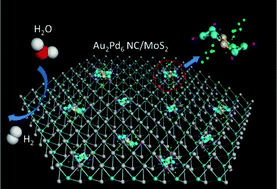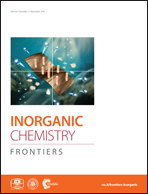Design of atomically precise Au2Pd6 nanoclusters for boosting electrocatalytic hydrogen evolution on MoS2†
Abstract
Atomically precise nanoclusters (NCs) have been widely used as catalysts in many reactions to investigate the structure–activity relationship due to their ultrasmall sizes, well-defined structures and precise compositions, especially bimetallic NCs can further promote the catalytic activity by the synergistic effects of heteroatoms. For electrocatalytic hydrogen evolution reaction (HER) catalysts, a common method to improve the performance is coupling with a nano-metal, but the origin of the enhancement is still unclear due to the diversity and complexity of the nanometal supported composites. Here, we take MoS2 (a star HER electrocatalyst) as an example, to report a strategy to boost the activity and give insight into the activity enhancement of it by combining with bimetallic atomically precise NCs. The crystal structure of this new NC is determined by X-ray crystallography, and its precise composition is identified as Au2Pd6S4(PPh3)4(C6H4F2S)6 (Au2Pd6 for short). The Au2Pd6/MoS2 show significantly improved HER activity and robust durability compared to the single component Pd3 or Au2/MoS2 and bare MoS2. This is attributed to the appropriate adsorption behavior of H atoms on Au2Pd6/MoS2 and the electronic interactions between NCs and MoS2, according to the combination of experiment and theory. This study presents a new strategy to improve the electrocatalytic activity of 2D materials such as MoS2 and sheds light on the origin of the promotion effects at the atomic level.



 Please wait while we load your content...
Please wait while we load your content...